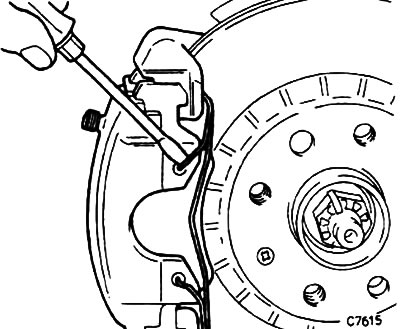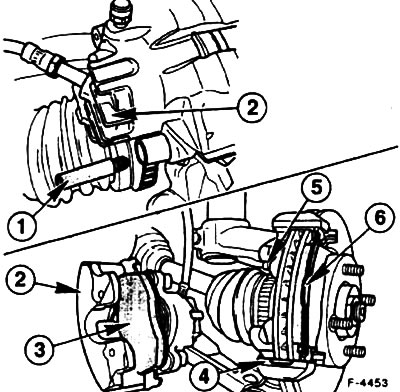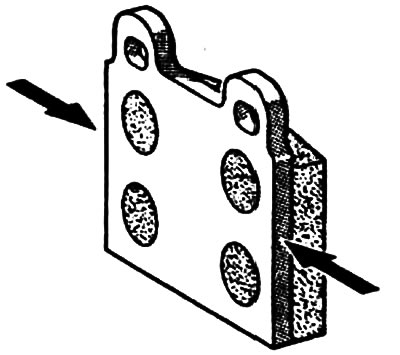Withdrawal
Mark the position of the wheels on the hub with paint in order to install them in their original place during assembly. Loosen the wheel nuts with the vehicle lowered. Raise the front of the car and remove the front wheels.

Remove the brake hose -6- from the bracket -7-. 1 - brake caliper, 2 - brake caliper, 3 - retaining spring, 4 - brake disc, 5 - brake hose mounting bracket.
Pull the brake caliper outward by hand to push the piston in slightly.
Remove the pad wear sensor.

Remove the retaining spring with a screwdriver.
Remove the guide pin caps with a screwdriver.

Unscrew the two guide pins -1- from the bracket -2-.
Attention! Leave the brake hose connected, otherwise it will be necessary to bleed the brake system.

Remove the brake caliper together with the inner shoe and hang it on a wire hook on the shock absorber strut. In this case, the hose must not be stretched or twisted.
Remove outer brake shoe -6- from brake caliper -4-. 5 - Caliper mounting bolt (pic. F-4453).
Separate the inner pad from the piston. The block is attached to the piston with a stopper.
Attention! If you intend to install the same pads back, then mark their location when removing them. Changing pads in places is unacceptable, as this will lead to uneven braking. Use only genuine FORD pads or those approved by the FORD factory. Replace all disc brake pads at the same time, even if only one pad has reached its wear limit. Different wear of the linings is not a reason for complaints. If the difference in the thickness of the inner and outer lining is more than 2 mm, then check the ease of movement of the piston, as well as the brake calipers in the guides, replace if necessary (service station operation).
Installation
Attention! Do not press the brake pedal with the brake pads removed, otherwise the piston will be squeezed out of the housing. If the piston is inadvertently squeezed out of the body, then remove the bracket and assemble it in a specialized workshop.
Clean the guide surfaces and pad seats in the body shaft with a suitable soft metal brush and clean with a vacuum cleaner or a cloth dampened with alcohol. Do not use solvents containing mineral oils or sharp-edged tools for cleaning.
Before installing the pads, check the surface of the brake disc with your finger for the absence of scratches. Measure the brake disc thickness see point 15.3.

Push in the piston with the tool. You can also use a hardwood block for this (hammer handle), at the same time make sure that the piston does not warp, try not to damage the surface of the piston and anther.

Attention! When the piston is pressed in, the brake fluid from the brake cylinder is squeezed out into the expansion tank. Monitor the fluid level in the tank, if necessary, remove the fluid from the tank with a rubber bulb.
To draw off the brake fluid, use a bleed vessel or a plastic vessel that will only be used for brake fluid. Do not use drinking utensils! Brake fluid is poisonous, never use your mouth to suck it out through a hose. Use a rubber bulb. After replacing the brake pads, do not fill fluid above the mark "MAX" on the reservoir, as brake fluid expands when heated. Leaking brake fluid gets on the master cylinder, destroys the paintwork and contributes to the formation of rust.
Attention! If the brake pads wear quickly, check the ease of movement of the brake cylinder. To do this, insert a wooden block into the brake caliper and slowly depress the brake pedal (assistant). The piston should move easily in and out. When checking, the second bracket with pads must be installed. Make sure that the piston is not squeezed out of the cylinder completely. If the piston is hard to move, replace the bracket (service station operation).

The following operation is optional, but desirable: In order to eliminate the squeaking of disc brakes, you can lubricate the back surface of the pad and the sides of the plate -arrows- with a thin layer of grease (e.g. Plastilube, Tunap VC 582/S, Cheevron SRJ/2, Liqui Moly LM-36 or LM-508-ASC). The paste must never get on the brake discs and linings. If this happens, wash off the grease immediately and wipe the pads or disc with alcohol.

Install the inner lining with stop plate on the piston.
Install the outer lining to the brake caliper.
Slide the caliper body over the brake disc, guiding the body into the groove in the brake caliper.
Turn down and push the bracket body.
Coat the threads of the clean, dry guide pin with a locking paste such as Loctite Tour 262 and tighten the pin to 30 Nm.
Slide the cap onto the guide pin.
Install the brake hose in the holder.
Install the front wheels so that the marks made earlier coincide. Apply a light coat of grease to the centering surface on the wheel hub before installing the wheels. Screw on the wheel nuts. Lower the vehicle and tighten the nuts crosswise to 100 Nm.
Attention! Depress the brake pedal several times until you feel good pedal resistance. Thus, the pads will press against the brake disc and take their working position.
Check the fluid level in the expansion tank, top up if necessary "MAX".
Brake the vehicle several times by gently depressing the brake pedal from 80 km/h to 40 km/h.
Attention! During the first 200 km, avoid unnecessary emergency braking.
Note! Brake linings are disposed of as special waste.
Visitor comments